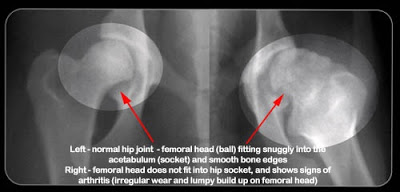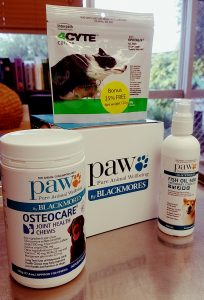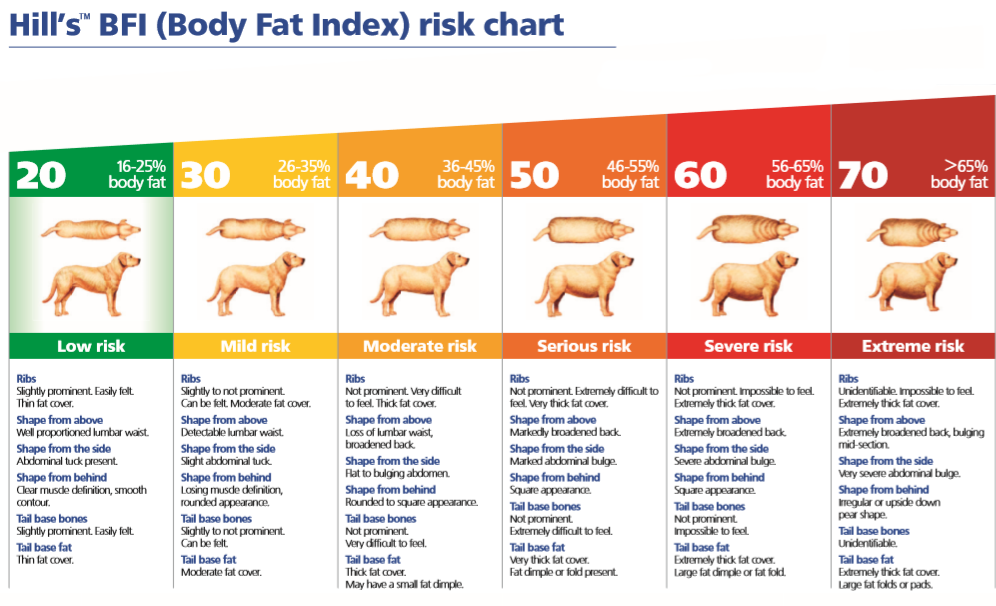What is Degenerative Joint Disease?
Degenerative joint disease (DJD) and osteoarthritis are the most common cause of chronic pain in both cats and dogs. DJD is most commonly found in the following areas of the body in companion animals:
- Front leg – shoulder, elbow, carpus (wrist)
- Back leg – hip, stifle (knee), hock (ankle)
- Spine
DJD is most often the result of damage to the cartilage of a joint due to either trauma or normal wear and tear (which is especially common in overweight animals). Cartilage acts like a natural shock absorber by minimising stresses on the ends of the bones as your pet moves around. When cartilage damage happens, inflammation occurs, resulting in the destruction of more of the cartilage in the joint and subsequently the underlying bone. Cartilage does not contain nerves by the underlying bone does and by the time your pet shows signs of damage the damage to the cartilage and underlying bone are well underway. Degeneration of the joint cannot be fully reversed and treatments focus on preventing or slowing the progression of the damage.
The most common signs of DJD are:
- Reluctance to exercise
- A pet that is stiff when it gets up from rest but then appears fine once they “warm up”
- Trouble climbing up stains or getting up into the car or onto their bed
- Limping
- Licking or chewing of the skin over a joint
- A pet that seems depressed, withdrawn or quiet and wants to spend less time with the family than they used to
What can we do to help?
The pain of DJD is best addressed by a combination of several approaches that will give a better result that any single treatment. Numerous products and therapies are available to help of deal with the effects of DJD in your dog.
Weight loss
Weight loss is the most important part of any approach to the treatment plan for a pet suffering the debilitating effects of DJD. Reducing an animal’s weight will lead to a decrease in the load applied to the joints and this, in turn, will significantly slow down the rate of damage and reduce the pain experienced by the animal. In some cases it can reduce or even stop the need for other forms of pain relief. The optimum weight loss target is 1-3% of body weight weekly and this can be achieved by following some simple rules.
- It is essential that the diet be calorie restricted and you must know the calorie content of the food being fed otherwise you cannot determine how much to feed your pet for optimal weight loss. A commercial weight loss diet is the easiest and safest way to achieve this. Some Veterinarians may be able to design a suitable homemade diet if this is your preferred option.
- A diet high in fibre will allow a decrease in the calorific density of the food while allowing your pet to feel full.
- The protein content of a weight loss diet is also important. Higher protein levels minimise the amount of lean muscle mass that will be lost, increases the palatability of the food and, in combination with a diet high in fibre, increases satiety.
- L-carnitine is a compound composed of amino acids (the building blocks of protein) that is required for the generation of metabolic energy for the body. This compound has been demonstrated to increase fat metabolism and is now included in all good quality commercial weight loss pet foods.
Exercise
Swimming and other low impact exercises are an excellent way of improving the comfort levels of your pet. Exercise facilitates the strengthening of the muscles that hold the skeleton together and this helps to reduce the stresses on your pet’s joints. There are some conditions that must be observed to get the full benefit of exercise:
- The exercise must place as little stress on the joints as possible and the best exercise of all is swimming or walking in belly deep water.. Bear in mind that swimming in very cold water has the potential to make the joint pain and stiffness worse.
- Of swimming or exercising in water is not possible then walking on level ground and restricted on a leash is the next best thing.
- Any exercise should be increase lameness and should be avoided if your pet’s lameness or pain worsens.
Prescription Drugs
Pentosan polysulphate is an injectable drug that is useful in treating DJD that is suitable for both cats and dogs. The major effects of the drug are increasing cartilage production and decreasing cartilage destruction. It is also known to promote increased blood supply to the joint and reduce joint inflammation. Pentosan is given as a course of injections under your pet’s skin (similar to when they get their yearly vaccination); one injection is given weekly for 4 weeks; the one a month for 3 months; then one every 3-6 months depending on how your pet is going. There is also an oral form of the drug which is good for those pets that do not like a trip to the vet.
Non-steroidal anti-inflammatory drugs (NSAIDS), such as Metacam (Meloxicam) and Onsior are the mainstay of relief from the pain associated with DJD. These types of drugs reduce inflammation and, in doing so, they block the pain and cartilage damage associated with joint inflammation. These drugs are generally fine for dogs but must be used with caution in cats. For older animals it is advisable to screen them for any pre-existing kidney and liver conditions before prescribing NSAIDS and 6 monthly monitoring tests are often recommended if your pet is prescribed these drugs. It is also important to add that human drugs should not be used on your pets without specific instruction on how to do so by your Veterinarian as many of the drugs that are appropriate for us, such as the commonly available Ibuprofen, are not suitable for use in animals and their use can lead to serious illness or death.
There are a range of other drugs that can provide analgesia for your pet and can be prescribed by your vet to be used in combination with NSAIDS or in the place of NSAIDS if they are not suitable for your pet.
Neutraceuticals and Herbal Remedies
These are helpful supplements to the diet of any animal but should be considered as an essential starting level for any pet with DJD. They are not a “quick fix” and the effects, while not dramatic, will be very helpful and complement any treatment with other medications prescribed by your Veterinarian.
Omega 3 Fatty Acids are a useful addition to the armoury of treatment options for animals suffering from DJD. Omega 3 Fatty Acids have been shown to reduce joint inflammation and pain, slow cartilage degeneration and  improve blood supply to the joints.
improve blood supply to the joints.
Glucosamine and Chondroitin sulfate are a synergistic combination of compounds that are natural components of the cartilage matrix and synovial fluid and can help to provide relief from the pain of DJD. Glucosamine is a major building block of the structural units in cartilage. These structural units are important for the elasticity, resilience and shock-absorbing properties of cartilage. Supplementary glucosamine sulfate helps reduce cartilage wear, increase joint mobility and decrease joint stiffness in osteoarthritis. Chondroitin, like glucosamine, is a natural component of cartilage. Chondroitin is also involved in the lubrication and nutrition of the joint, and helps the joints to resist compression. Supplements containing glucosamine and chondroitin often come in combination with other compounds that are believed to improve joint health such as manganese and boron.
Anti-inflammatory herbs, from both Western and Chinese herbal medicine, are frequently used for the pain of DJD in humans; some of the most popular of these are Ginger, Devil’s Claw, Boswellia, Meadowsweet and Yucca. The use of herbal medicine may be of benefit for pets that cannot tolerate standard veterinary pharmaceuticals such as NSAIDS. A Veterinary herbalist or human herbalist with the guidance of a qualified Veterinarian will be able to prescribe an appropriate combination of herbs for your pet should you choose this mode of treatment.
Environment
Whether your pet lives inside or outside you will need to make sure they have a warm and comfortable place to rest. Cold and damp weather can aggravate arthritis in our pets, as it does in humans. Any bed you get for your pet needs to be able to prevent them from being exposed to draughts and have the ability to distribute their weight properly to take excess weight off their joints. Extra foam layers, such as the foam mattress toppers that we use for ourselves, are a good addition in that they provide thermal insulation and padding. If your dog sleeps outside another useful addition is a padded coat.
Alternative Therapies
Acupuncture has been increasing in popularity in both human and veterinary medicine for the treatment of chronic pain. While the exact way in which acupuncture works is unknown it seems to have pain reliving effects in some animals. If you decide you would like to try acupuncture for your vet it is important to find a vet with International Veterinary Acupuncture Society (IVAS) certification as they have been trained in both traditional veterinary medicine and acupuncture techniques. To find a qualified vet contact the Australian Veterinary Acupuncture Group (www.acuvet.com.au).
Massage to improve blood flow to the tissues and reduce pain is something you can do for your animal at home. While it will not provide any long term permanent benefits it will certainly give some immediate pain relief.
Some animals have been found to respond well to chiropractic manipulations of the spine as well as the other joints. Chiropractic treatment, like acupuncture, is best performed by a qualified Veterinary Chiropractor who has completed the Graduate Diploma or Masters Degree Veterinary Chiropractic courses at University. To find a qualified Veterinary Chiropractor contact the Australian Veterinary Chiropractic Association (www.chirovet.com.au).
In Conclusion
Give your pet the best chance of avoiding or reducing the development of DJD by observing these simple suggestions.
- Exercise care in the feeding of your pet to help them maintain a healthy body condition: excessive weight is one of the main enemies of joint health.
- Give your dog plenty of exercise to help maintain a healthy weight and promote joint stability and health.
- Start dietary supplements, such as Omega 3 Fatty Acids and glucosamine & chondroitin, before arthritis actually sets in to help maintain good joint health and to help minimise joint deterioration.
- Provide you pets with a warm & soft place to sleep.



